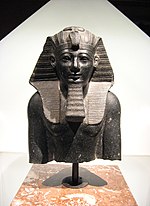Thutmose III
| Thutmose III | |||||
|---|---|---|---|---|---|
| Tuthmosis III, "Manahpi(r)ya" in the Amarna letters | |||||

| |||||
| Statue of Thutmosis III at the Kunsthistorisches Museum, Vienna | |||||
| Pharaoh saka Mesir kuna | |||||
| Kuwasa | 1479–1425 BC, 18th Dynasty | ||||
| Sadurungé | Hatshepsut | ||||
| Pengganti | Amenhotep II | ||||
|
Royal titulary
Lasting is the Manifestation of Re[1] Thoth is born, beautiful of forms Mighty Bull, Arising in Thebes Enduring in kingship like Re in heaven Powerful of strength, holy of diadems | |||||
| Consort(s) | Satiah[2], Hatshepsut-Meryetre, Nebtu, Menwi, Merti, Menhet | ||||
| Putra | Amenemhat, Amenhotep II, Beketamun, Iset, Menkheperre, Meryetamun, Meryetamun, Nebetiunet, Nefertiry, Siamun[3] | ||||
| Bapak | Thutmose II | ||||
| Ibu | Iset | ||||
| Pati | 1425 BC | ||||
| Pamakaman | KV34 | ||||
| Monumèn | Cleopatra's Needles | ||||
Thutmose III (kadhang-kadhang diwaca Thutmosis utawa Tuthmosis III lan tegesé Putrané Thoth) iku Pirngon kang kaping-6 saka Dinasti Mesir angka 18. Sajeroning rolikur taun pisanan saka kakuwasaan Thutmose, panjenengané ngatur bebarengan karo ibu sambungané, Hatshepsut, kang diangkat dadi Pirngon. Hatshepsut katon ing patilasan kang isih ana, kaloroné duwé asma bangsawan lan lambang lan ora ana kang cetha endi kang luwih senior utawa luwih kuwasa.[4] He served as the head of her armies.
Sawisé Hatshepsut séda lan Thutmose diangkat dadi Pirngon, panjenengané nyipta kakaisaran Mesir kang gedhé dhéwé; ora kurang saka 17 paprangan dianakaké, lan panjenengané naklukaké wiwit saka Niy ing Suriah Lor, nganti papat grojogan Kali Nil ing Nubia.
Uga delengen
| Wikimedia Commons duwé médhia ngenani Thutmosis III. |
- Cleopatra
- Sajarah Mesir kuna
Rujukan
- ↑ Clayton, Peter. Chronicle of the Pharaohs, Thames & Hudson Ltd., 1994. p.104
- ↑ Dodson, Aidan. Hilton, Dyan. The Complete Royal Families of Ancient Egypt, Thames and Hudson. p132. 2004. ISBN 0-500-05128-3
- ↑ Pélik sitiran: Tenger
<ref>kanthi jenengRoyalFamilies p132.ora bisa dipratuduhaké amarga diwedharaké sajabané pérangan sing saiki utawa ora diwedharaké babar pisan. - ↑ Partridge, R., 2002. Fighting Pharaohs: Weapons and warfare in ancient Egypt. Manchester: Peartree. Pages: 202/203
Wacan
- Redford, Donald B., The Wars in Syria and Palestine of Thutmose III, [Culture and History of the Ancient Near East 16], Leiden: Brill, 2003. ISBN 90-04-12989-8, treats the military annals of Thutmose III, with regard to his conquests in the Levant
- Der Manuelian, Peter, Studies in the Reign of Amenophis II, Hildesheimer Ägyptologische Beiträge(HÄB) Verlag: 1987
- Cline, Eric H. and O'Connor, David, Thutmose III : A New Biography, University of Michigan Press, 2006. ISBN 0-472-11467-0, incorporates a number of important new survey articles regarding the reign of Thutmose III, including administration, art, religion and foreign affairs
- Reisinger, Magnus, Entwicklung der ägyptischen Königsplastik in der frühen und hohen 18. Dynastie, Agnus-Verlag, Münster 2005, ISBN 3-00-015864-2
- Breasted, James Henry.Ancient Records of Egypt, [Volume Two, The Eighteenth Dynasty], University of Illinois Press, 2001.ISBN 0-252-06974-9
- River God by Smith, Wilbur along with the rest of his egyptian series of historical fiction novels are based in a large part on Thutmose III's time along with his story and that of his mother through the eyes of his mother's vizier mixing in elements of the Hyskos' domination and eventual overthrow.